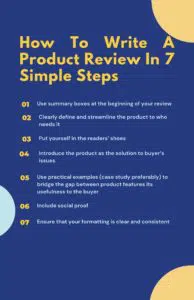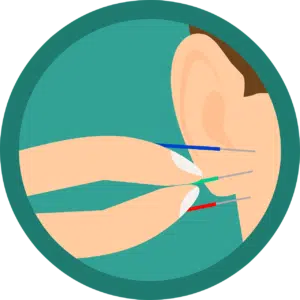How To Write A Product Review – Examples Included
From our experience of over a decade in the digital and affiliate marketing space, we have seen numerous product reviews pushed around the web. To be frank, we believe the quality could be better. And trust us, we, SuperStar SEO, aren’t the only ones who hold such grounds – even Google does! That’s why there was a recent update in April about how to write a product review.
Unfortunately, Google’s product review update is a bit cumbersome and confusing for most parts. But don’t fret; we’ve simplified the update in this robust guide.
And, we did even better than just simplifying the update; we compiled this ultimate guide on how to write product reviews in the most practical and comprehensible way. Plus, we included insights and examples from “personally” tested and proven methods.
So, it doesn’t matter if you’re a beginner product review writer (or a pro), an affiliate marketing enthusiast, or a digital marketing guru. This guide contains everything you need to write product reviews for SERPs and humans.
In summary, this guide will enlighten you on the following details:
- Understanding the gaps in the numerous product reviews published on the web,
- How to write a product review in 7 simple steps,
- Pre-selling vs. selling: which one is better?
- Convincing buyers to buy through your product review with the principle of reciprocity, and
- Formatting reviews for better results
That said, let’s delve into this robust guide on how to write a product review!
The Gaps In The Numerous Product Reviews Published On The Web

The best way to explain the shortcomings of product reviews is to view them from a buyer’s perspective. So, imagine yourself as one:
You visited Google and typed a product you’d like to buy to see its reviews. What comes up? Multiple sites with clickbait-ish titles on questionable domain names!
Say you indeed find some trustworthy domain names. The review content on such sites is often too thin. If the content were thin but personalized, that would still count for something – but they are not.
What you’d get, instead, are generalized, regurgitated content that are only mumblings about product features. But does that help you? Would you commit your hard-earned money to a product that you don’t understand how it can help you?
The answer is probably a no. Well, that right there is the gap in the numerous product reviews on the internet. They lack the personalization and persuasion that turns prospects into buyers.
Now, you might argue that buyers did visit the review content at least. While that is great, it is not efficient for revenue generation – it only tells us you’ve done excellent SEO.
Related reading: SEO Affiliate Marketing For Dummies – A Complete Walkthrough
To rank your product reviews and actually sell the “products,” you need to do more than just SEO. What more?
- Tell the truth about the products you’re reviewing – be brutal as much as possible. That would instantly show your credibility.
- More importantly, back up product features with practical benefits. If product “A” has an “X” feature, tell buyers how “X” can solve their problems.
And that’s it: the right way to write product reviews in summary. How about the full detail in steps with even more examples?
How To Write A Product Review In 7 Simple Steps

Before we delve into the steps, here’s a quick breakdown – in case you want to jump to some sections:
- Use summary boxes at the beginning of your review
- Clearly define and streamline the product to who needs it
- Put yourself in the readers’ shoes
- Introduce the product as the solution to buyer’s issues
- Use practical examples (case study preferably) to bridge the gap between product features its usefulness to the buyer
- Include social proof
- Ensure that your formatting is clear and consistent
Use Summary Boxes At The Beginning Of Your Review
If you had noticed, you’d see how we summarized the points in this article before we explained them. Well, that is what summary boxes do – they aggregate ideas into snippet-ish takeaways for readers.
Now, considering that product reviews can sometimes revolve around boring context, a summary box is critical. With one, you can instantly give your readers a breakdown of the products they can expect and save their time.
In particular, a summary box is another opportunity to hasten the buying process. How so?
The chances are that a buyer is already motivated to buy a product. Perhaps it was a recommendation from a friend or relative. In that case, the motivated buyer only needs a few more persuasion (from a trusted review site) to buy. In other words, he’s not waiting around to read your entire article.
Instead, the said buyer wants a quick summary and purchase link. Fortunately, that’s what summary boxes do!
However, your summary box must contain a few elements for it to convert your buyers. Here are the crucial ones you should note:
-
- An opening sentence that states the product’s name and its use.
- A 5-star model rating for the product – focusing on factors such as effectiveness, rigidity, customer support, and value money.
- Include a perfect reflection of the product’s merits and demerits. Else, your review would lack originality.
- The price of the product – displayed to the least amount. If there were variations because of size and color, you should include such details too.
- Close the box with a 1-2 paragraph summary.
- Lastly, include a CTA in the summary box – but be subtle and creative about the copy. That way, you’d avoid being salesy.
Clearly Define And Streamline The Product To Who Needs It
Even after the summary boxes, you still have a long way to go to learn how to write a product preview. That brings us to product streamlining!
Let’s face it; not all products will meet your readers’ needs. Confusing, eh?
Let’s use an example. Say you have a ski gear review site, and you put a review about the best ski lock in 2021. Now, every lock is not the same. Some locks are lightweight, while others are rugged and heavy.
Yet, some of these locks are “smart” devices, and the others are conventional types. Imagine all those variations – it can even confuse your reader.
To avoid confusing your audience, clearly state who your product is for in your review content. About that, we’ll advise you to create a specific section for this purpose – and it is best if it comes after the summary box.
Now, you might be wondering, what if the buyer doesn’t want the product you’re reviewing and leaves your site?
Well, that’s not an issue. You’ll gain credibility even if the buyer leaves. Because at that point, it will be obvious you want the best for your audience. Besides, before he (the buyer) leaves, you can suggest alternative products to him.
Now, your alternatives could be a similar brand to what your buyer wants or a complementary product. Either way, you will have another shot to convert more sales. But first, ensure you create a section too for alternative products. You can list that at the footer of your “originally reviewed” products.
Also read: Best Niche Ideas For Affiliate Marketing & Online Business
Put Yourself In The Readers’ Shoes

Earlier, we advised you to be truthful and brutal with your reviews – call a spade a spade. Well, doing so is putting yourself in your readers’ shoes. Ordinarily, your audience can visit companies’ websites if all they want is a list of benefits with no personalization to them.
Besides, this is review content and not an article to highlight only features. So, do your part; you probably won’t like half-baked review content bent only on fulfilling a word count and affiliate links. If you won’t, then your readers won’t too!
Furthermore, your empathy is a sure way to beat your competition. It endears your audience to you. In turn, they will trust you and perhaps buy from only you.
And like we always say at SuperStar SEO, always deliver on your promise – that’s the only way you can consistently make a fortune from the much competitive affiliate world. That said, how can you empathize with your readers? How can you write a product review using empathy?
Be A Real Person
Ditch the brand feel if you’re truly going all in for review content. We are not saying you can’t be “skireviewers.com.” What we mean is that you should address your audience as a person. How?
As much as possible, address your audience directly using “you.” Most importantly, share unique stories to explain your product reviews. For example, if you target South Carolina’s audience, use slang and expressions that reflect such places.
The bottom line: sound as human as possible. Else, your review content will probably come off as a spun or AI article.
Share The Problems You Faced Regarding The Product
Another way to show yourself as a real person is to share the problems you experienced that your audience is probably battling. And mind you, that should be the introduction of your review content. Explain the issues you faced and how product A has solved them.
Or, in the case of a product roundup, tell readers what influenced the listed products. More importantly, talk about how the listed products fare with insights from when you used them.
Apply Pressure On The Pain Points

This part is similar to sharing problems; the only difference is that you’d do more questions here. And since you already know the problems, this section means you will keep asking rhetorical questions.
However, ask questions strategically and only until your audience can perfectly picture your situation and how that product can help them just as it did you.
Note: throughout the content, don’t be presumptuous. Instead, use friendly language and be as casual as possible.
An example of how to write a product review using empathy (the introduction):
“I have never been one for exercises. The routines make me weak – for me, it’s like climbing a hill. You know the feeling, right?
Despite my laziness, I still want to burn fat and look gorgeous. For a long time, that approach looked futile. I even almost lost hope until I came across product X. To date, I’m still amazed at how effective it was.
So, are you like me? Would you love to continue with zero exercises and yet have a perfect body? Then, this review on product X can help you.”
Introduce The Product As The Solution To Buyer’s Issues

From the example we cited earlier, you can see how we introduced product X as the answer to a relatable problem. That approach is called pre-selling, and it is what you should implement for your product reviews henceforth.
However, to understand how pre-selling works, you need to know everything it entails and how it weighs against conventional selling. So, let’s enlighten you!
For a start, what is pre-selling?
Pre-selling, like the name, means conditioning your audience to buy from you – and to do so continuously. It is a process that starts with helping people choose a product with ease.
From there, pre-selling demonstrates the value of that product as subtly as possible without making you appear salesy. It does that by answering buyer questions even before they ask. In the end, you will endear your audience to your offers and lower their guard significantly.
Ultimately, pre-selling sells your products without the actual “selling” and its pressure. With it, you’re just creating an enabling environment that will bring continuous sales. And that right there is the difference between this concept and the traditional selling – and why you should enforce it on your product reviews.
That said, how can you introduce your products to your audience using pre-selling tactics?
- First, demonstrate to your audience how the product(s) you reviewed can solve a problem using yourself as an example. And while you are at it, include pictures (screenshots will be better) and videos – that would undoubtedly clear any air about the authenticity of your review content.
- Lastly, answer the questions and doubts that your audience might and would have about your product. You can start with some inquiries you’d ask if you were in their shoes. But ultimately, you’d need some keyword and product/market research.
Related reading: Long-Tail Keywords For Affiliate Marketing
Note: if you can, publish your demonstration videos on YouTube and optimize the captions. That way, you can generate additional traffic to your review content and improve your overall SEO aims.
Use Practical Examples (Case Study Preferably) To Bridge The Gap Between Product Features Its Usefulness To The Buyer
Spoiler alert: this step is a bit bulky than the others – but it’s worth the long read!
Like we have mentioned repeatedly in this article, merely listing product features is not how to write a product review. If you had followed that approach, you’d only be showing your audience that your content is a hoax and lose their trust – regardless of your pre-selling tactics.
What you should do instead is to explain the features of the reviewed product(s) using practical and relatable examples. And if you could create case studies, you’d simply be locking the attention of your prospects – and ultimately the commissions through their purchases.
Besides, writing a value-rich product review is what you owe to your audience. After all, what is worth doing at all is worth doing rightly.
Plus, there is an extra benefit to writing a value-rich product review. If your buyers get real value from your review content, they will feel like they owe you one. Hence, the principle of reciprocity!
Even if you’re not an affiliate marketer but someone who publishes resourceful content regularly, your audience would mostly email you to check your services or ask for a consultation. And we would know that fact because we get tons of feedback and call for help from the posts on our blog here at SuperStar SEO.
Now, imagine what the principle of reciprocity can do for you who actually earns a living through the affiliate links on your product reviews! Don’t you think the returns would be immense?
Even with the immense returns, you should know that including case studies in your product reviews can be hectic. Nevertheless, it is worth the time investment. That said, how can you create one?
What Are The Processes Involved In Creating High-Value Case Studies For Your Product Reviews?
- Understand The Purpose Of The Case Study
Without understanding your need for a case study, you would hardly create one that is resourceful for your audience. So, what is the purpose of a case study in a product review?
Earlier, we advised you to put yourself in your audience’s shoes. Well, case studies do the same thing, but for you. They create an imaginary world where your prospects can relive your experiences about a product and its effectiveness.
Now, you know the purpose of case studies – what next?
- Know The Features That Matter
Let’s face it: not all the features of a product matter. And, as weird as this may sound, what ultimately matters to buyers is the functionality of a product. Will the product fulfill the advertised functions?
Let’s use this example for a clear perspective:
If you’re buying a ski lock, what features would matter to you? Averagely, you would ask if the product will indeed protect your ski gear from theft. Will it be compatible with the majority of ski resorts all over the world? Is the material rugged enough to withstand the harsh conditions of the winter months?
After questions about the function features, you might wonder about the color of the ski lock (that’s even if you care). So, in this case, color isn’t a feature that matters – unfortunately. And, it would be time-wasting to create a case study on such a feature.
Bottom line: identify the core features of the products you’re reviewing – those would eventually be the focal points of your case study.
Hint: follow the features that highlight what the manufacturer said her product would do!
- Visualize The Core Features
After identifying the product features that matter, put them to action and visualize that to your audience. Now, there are several ways you can do that, but we’ll recommend the two approaches below:
- First, you can do a video – like we recommended earlier, use YouTube because of its SEO benefits. And don’t worry about your page speed or your audience leaving your review content; embed the YouTube video in your content.
If you don’t know how to embed a YouTube video in your content, this quick guide can help:
- Create the video that shows how you’re using the reviewed product – focus on the core features
- Publish it on YouTube
- After, click the share button and choose embed from the drop-down list
- Copy the link and paste it into your content – that’s it!
- Secondly, you can use a screenshot. This approach is straightforward and perhaps the easiest of two. However, ensure you include shots on the crucial steps of how you used the reviewed product. Most importantly, ensure that the picture quality is top-notch.
Pro tip: you can also embed your screenshots – it can preserve the image quality!
- Add Notes To Your Video And Screenshots
This last step is just a reminder to add voice to any media you’d share. If you’re using videos for your case studies, add a voice. About that, it is best if you use your voice and not some AI-generated undertone. And while at it, make the audio just as clear as the video.
On the other hand, if you’d use screenshots, add pointers or markers to direct your audience’s eye to what you meant in your explanations.
Overall, do a great job. Remember: the harder you try, the more you’d compel your audience to click on your affiliate link.
An Example Of Effective Case Study For Product Reviews
Perhaps you don’t know yet, but we have a product called Legiit Leads. It helps agencies and even freelancers get clients quickly and comfortably. And we did a product review for it – you can check that here.
If you click the link, you’d see that we did our product review in a somewhat unconventional way – we did it over live streams, with two anchors, and we showed our faces. That way, our audience knows we are real. Plus, we get to hear their feedback directly.
More importantly, we didn’t focus the review on selling Legiit Leads. Instead, we discussed the issues agencies face. Then, we highlighted the core features of our product and how it would help these agencies.
Lastly, we offered live free samples and showed our clients how they could use Legiit Leads. That way, they can see that our product is authentic and does what we say it does – efficiently at that!
Bottom line: you don’t necessarily have to do a live video for your product review – you might not have the audience. Instead, give your all. Answer the inquiries of your audience, and show them how the product can help. Then, you’d have a high-value case study. And, you can also be as creative about it as us.
Include Social Proof

Let’s ask you a quick question: why do you think product reviews and affiliate marketing as a whole is lucrative? Or don’t you know that the niche is lucrative?
Okay, say you don’t know that the niche is lucrative to start. How about this: why do you think review content gets tons of traffic?
The answer to both questions hinges on a single fact: customers trust recommendations and real people’s feedback (social proof). And that’s not some hogwash; we have stats that prove it – an incredible 87% of all buying processes begin with customers searching for such proofs.
So yes, social proof is a crucial part of marketing. And, review content plays its role in all of that. But even at that, do you know you can still add more proof to your product review? That probably sounded confusing, but it is possible.
Your product review can still house at least another three different kinds of social proofs:
- Customer/user social proof – comprises reviews of different customers just like you. If you’d add these kinds to your product reviews, ensure that they are detailed enough. Also, don’t add only reviews that match your opinion – insert the good, bad, and ugly.
Pro tip: if you don’t know where to find user social proof, you can check Amazon or the manufacturer’s site. But if you’re reviewing SEO services, you can check for additional reviews on marketplaces like Legiit.
- Expert social proof – comprises reviews from professionals on the products they use. For example, imagine that Marco Schwarz (winner of the 2021 Alpine skiing world cup) posted a positive comment on a ski lock in your review! Inserting such a comment in your content will automatically jolt your chances of sales.
- Certification – this social proof could be in the form of a safety standard or quality assurance. Either way, if a product on your review has approval from authoritative figures in its industry, include such proof in your content. Doing so will ease the worries of your audience.
Note: don’t claim other people’s reviews. Instead, create a section for them – you can tag it “reviews from other users.”
Furthermore, always quote any third-party proof in your content. Most importantly, leave a link back to the source. By doing so, you’ll increase your credibility and avoid plagiarism.
Also worth a look: How To Get Clients For Digital Marketing
Ensure That Your Formatting Is Clear And Consistent
The last step on how to write a product review is to ensure that it has a structure. If you don’t enforce a structure on your review content, it’ll be a long read and might even become exhausting for your readers.
But with a structure, your audience can toggle around your content, skim it, and easily find the information they seek. That said, we have compiled a few tips that can help you format your product reviews perfectly. Have a look!
Break Your Reviews Into Sections
Like all types of content, reviews are most comprehensible and easy to navigate when in sections. Plus, dividing your product reviews into sections gives even you, the writer, clarity. You’d know what details to discuss at every point and where you strategically place your keywords.
That said, ensure you have a rough sketch in your head about the sections you’d like to include in your review before you start writing. And while you’re at it, separate the sections and subsections with H1, H2, H3, and H4.
Pro tip: the longer your review content, the more sections you’d have. And in addition to headings 1-4, you can also separate your ideas with pictures or even videos.
Use Columns For Comparisons
In reviews like product A vs. B, we will advise you to use a column to summarize the differences. Else, your readers would get lost shuffling between the subsections for each product.
Then, after the summaries in the column, you can further explain how each product works under their respective subsection.
Note: you can use columns for the comparisons of more than two products.
Use Star Ratings

We understand that product rating could mean that your audience might not bother to read your review once the score is low. Even at that, still use it. And while you’re at it, use attractive graphics and symbols to indicate your ratings.
More importantly, include ratings at the end of each product in your review. You could make it like the conclusion or something like your score after all the evaluation.
Strategically Add Pictures And Screenshots
As much as you want to add plenty of pictures to your product review, we’d advise you to exercise caution. If you dilute your reviews with pictures, you risk turning the whole thing into a gallery with captions. So, what should you do?
Add images to your product using a 3-5:1 formula. In other words, for every 3-5 paragraphs, add a picture. Now, the picture should vary – shuffle between screenshots, product images, and memes (if you don’t mind a little bit of casualness).
Be Creative With Your CTAs

Even though pre-selling is the ultimate way to sell your products, you should still include intentional CTAs in your review. And for this part, we’d ask you to be creative. How?
Ditch the conventional “buy now.” Instead, you can use something unique about the products in your review like:
- Get product A’s 25% student discount
- Learn more about product A’s warranty
- Read more on how to get free shipping for product A
Pro tip: Ensure that your CTAs stand out – use attractive fonts and colors to catch your audience’s attention.
And that’s it: how to write an SEO-friendly product review that is also highly resourceful to buyers. However, note that you might not get it right at the first trial. Even at that, keep at it, and you’d see improvements in your review content. All the best!





